KÀ
Wednesday, July 23, 2008
I have never seen any Cirque du Soleil show—despite that I have lived in Montreal for five years. Circus is never my cup of tea and I ignored the 2004 Midnight Sun for the Jazz festival—I dislike any orgy on the street since I have to stand and watch. But I heard that their major resident shows are quite different: the only inconvenience—they are in Las Vegas. And the reason is simple: they all need special designed theater and a devoted show-going audience to cover the huge production cost.
There are five shows by Cirque du Soleil in Vegas. They are O, KÀ, Mystère, Zumanity and Love[1], of which I need to choose one (budget reason). So KÀ. This is because this show is designed by Robert Lepage, one of the best Canadian filmmakers. Lepage is well known in Quebec cinema, but his major area of work is still theater, in which he is an accomplished international celebrity (better than Bergman). And I have not been able to catch a glimpse of his theater work either. So this would be a double opportunity for me to fill in the blanks of being a Montrealer.
I am not sure to which extent Lepage is responsible for the show. But he certainly helps to transform the traditional style of a circus show into a different animal. There are still vestiges of this traditional style, that is to say, the circus elements. But overall it carries a distinctive flavor of a mixture of oriental fantasy[2], innovative stage design and multimedia incorporation—all Lepage’s repertoire. It also tells a story better: conflict, dualism, etc.
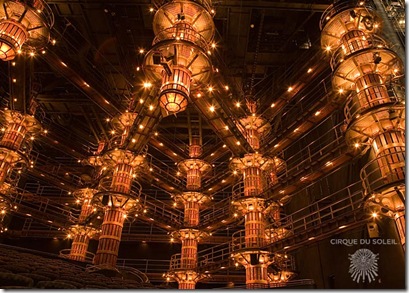 Upon arrival, guests are showed in by gatekeepers, which are just your average usher dressed in fancy costumes—they come in handy when you need a souvenir photo. When one first enters the theater, one notices that on two sides there are gigantic metal works—platforms, stairs—that extends the stage far into the audience area. We expect it to produce astonishing effects during the show, which is not exactly the case—it might be a potential that can be fully exploited in future revisions.
Upon arrival, guests are showed in by gatekeepers, which are just your average usher dressed in fancy costumes—they come in handy when you need a souvenir photo. When one first enters the theater, one notices that on two sides there are gigantic metal works—platforms, stairs—that extends the stage far into the audience area. We expect it to produce astonishing effects during the show, which is not exactly the case—it might be a potential that can be fully exploited in future revisions.
The way KÀ demonstrates how there is to be no flash photography or cell phone usage is exemplary. Several minutes before the show starts, the counselor and his son (both bad guys, mind you) invite someone from the first row. While they are engaged in some harmless talking, we hear phone rings from this unfortunate guy’s pocket. He is immediately thrown into a bottomless pit that is the stage—with a harrowing scream.
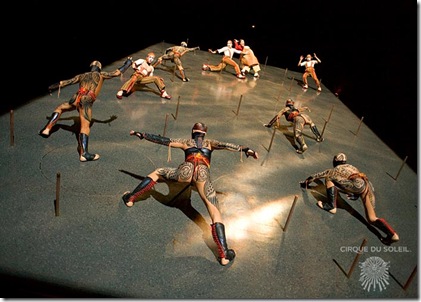 What is most noteworthy of the KÀ show is definitely its floating stage, 25 x 50 feet and weighing 50 tons. It creates unprecedented visual variation to traditional stage art in that this platform can rotate to any imaginable degree of tilt. At one scene, it emulates a steep mountain where the princess and her escorts try to evade and fight their relentless pursuers. Here the platform is seen virtually vertical, with protruded shafts—assumed arrows—on various spots. The performers climb up and down the platform with the help of these shafts with a truly acrobatic agility. Note that the shafts are individually controlled and their appearance and disappearance are carefully choreographed with the action. Therefore I assume the route by which those acrobats maneuver the platform is far from random. Towards the end of the scene, the savage pursuers fall one by one; the last of them hangs by the shaft and then lets go, falling into the pit. Thus we are suddenly made aware that those shafts have all been withdrawn.
What is most noteworthy of the KÀ show is definitely its floating stage, 25 x 50 feet and weighing 50 tons. It creates unprecedented visual variation to traditional stage art in that this platform can rotate to any imaginable degree of tilt. At one scene, it emulates a steep mountain where the princess and her escorts try to evade and fight their relentless pursuers. Here the platform is seen virtually vertical, with protruded shafts—assumed arrows—on various spots. The performers climb up and down the platform with the help of these shafts with a truly acrobatic agility. Note that the shafts are individually controlled and their appearance and disappearance are carefully choreographed with the action. Therefore I assume the route by which those acrobats maneuver the platform is far from random. Towards the end of the scene, the savage pursuers fall one by one; the last of them hangs by the shaft and then lets go, falling into the pit. Thus we are suddenly made aware that those shafts have all been withdrawn.
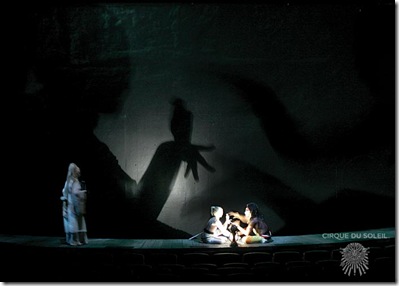 Such is undoubtedly the forte of Cirque du Soleil production. But what I find especially touching is another scene where the twin brother is taught the art of shadow play by the protective court jester. Again the platform is seen vertical, with its smooth surface reflecting shadows from a powerful lamp installed just in front of the two performers. The positioning is such that the shadow of their hands are magnified so that all audience can have a clear view. Now I imagine we all more or less played the same game when we were young—often when there is a blackout—but it is truly amazing to see that such a simple trick can become so vivid, so poignant. The whole experience is beyond description and amounts to, at least for me, an overwhelming nostalgia of the lost childhood.
Such is undoubtedly the forte of Cirque du Soleil production. But what I find especially touching is another scene where the twin brother is taught the art of shadow play by the protective court jester. Again the platform is seen vertical, with its smooth surface reflecting shadows from a powerful lamp installed just in front of the two performers. The positioning is such that the shadow of their hands are magnified so that all audience can have a clear view. Now I imagine we all more or less played the same game when we were young—often when there is a blackout—but it is truly amazing to see that such a simple trick can become so vivid, so poignant. The whole experience is beyond description and amounts to, at least for me, an overwhelming nostalgia of the lost childhood.
It also has to be said that the show makes extensive usage of the versatility of the platform’s surface. As mentioned it serves the backdrop of a masterful shadow play. It is also used in the final confrontation of the two armies, to have video sequences projected on it, where the platform is again vertical. The effect is that whenever a soldier steps onto the platform (they are all airborne), it produces a small whirlpool as if he is tapping on the water. If this video sequence is prerecorded, then each performer must hit exactly the right spot on the right time—which is definitely too difficult. Otherwise there must be a technology, motion detectors or touch sensors for example, that can evoke computer generated whirlpool graphics whenever a performer touches the surface.
In another scene the platform emulates a sea shore—hence it is entirely covered with yellow sand (actually made of granular cork imported from Portugal). We have some cartoonish characters here: silly turtle, mischievous starfish (urchin), crab and even a potato bug—all human performers disguised. Later when the scene ends the platform just tilts up to get rid of all the sand.
You may get the impression that the platform is a perennial presence on the stage. Well it is not. In several scenes the stage space is penetrated up and down—it breaks the bottom of the stage, one might say. Because human vision is essentially horizontal, stage entrances are normally left and right, seldom up and down. But this show frequently uses these other two sides to make entrance and exit. There is especially a unforgettable scene in which the stage emulates the twin brother plumping into the ocean bottom. With the help of lighting, and bubbles—no idea how this is done—the visual effect is mesmerizing. Then the jester swims heads-down to retrieve the boy and they both emerge upwards.
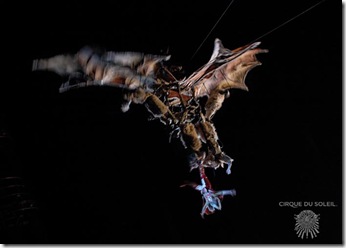 Yet another scene features a gliding bird which hovers above the audience before descending into the pit/abyss. But the itinerary of the flight is pre-defined and lacks much suspense.
Yet another scene features a gliding bird which hovers above the audience before descending into the pit/abyss. But the itinerary of the flight is pre-defined and lacks much suspense.
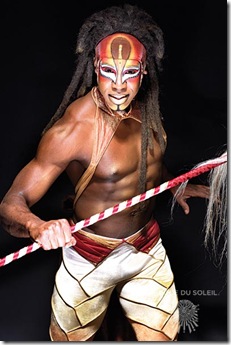 Other less impressive scenes include the first, where the imperial court celebrates with a sequence unmistakably borrowed from Beijing opera. Staffs and spears are flying in the air with performers bouncing them constantly and exchanging positions. Palatable to most of the audience, I imagine, but a bit tedious for a
Other less impressive scenes include the first, where the imperial court celebrates with a sequence unmistakably borrowed from Beijing opera. Staffs and spears are flying in the air with performers bouncing them constantly and exchanging positions. Palatable to most of the audience, I imagine, but a bit tedious for a 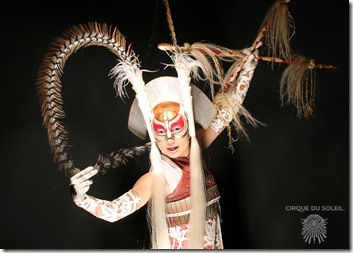 Chinese. It is said that this sequence also borrows from the Brazilian Capoeira dance. Both resemble martial arts yet are distinctively different.
Chinese. It is said that this sequence also borrows from the Brazilian Capoeira dance. Both resemble martial arts yet are distinctively different.
I think a complete transformation of the circus show is to let the acrobatic acts serve a narrative or stylistic purpose. In other words, acrobat for acrobat’s sake damages the show. Some of the above instances manifest a good example of this transformation while some other scenes are too conspicuously circus style. After the Chief Archer's daughter sets the twin brother free, she had some time of her own to play a solo with a flute. Haven’t we seen enough rhythmic gymnastics? If she can do a hundred clubs at once I might even applaud. But she got only two. Later, in the slave cage scene, two acrobats walk the spinning wheel, clockwise, or counterclockwise. What’s the point? As if all of a sudden the plot gives way to some nonsensical and low grade entertainment. The beach scene, too, reminds me of this type of interlude that shows up in virtually all vaudeville. It never fails to entertain its audience, for sure. But it weakens the plot.
Overall I feel that this show is at times brilliant, at times insipid. If this is already the better of Cirque du Soleil shows, I am afraid the others wont be able to meet my standards. A show has a long way to go to match the kind of narrativity cinema or traditional theater can furnish. But come to think of it, I believe most of the audience are there looking for visual impressiveness as the main ingredient. This is why although some of the acrobatic acts fail to function in the narrative, they are still wholeheartedly welcomed. I am sure Lepage is aware of this, but for the same reason, he cannot afford to not to include them.
[1] The new one, Criss Angel BELIEVE (Luxor) will premier shortly.
[2] The language these characters use sounds most like Japanese, but naturally it is not.
edit
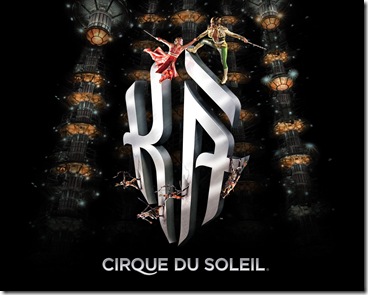
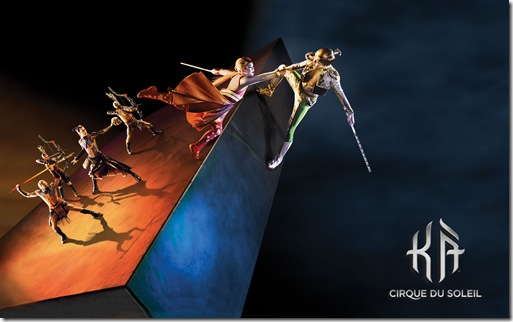


1 comment:
Thank you for the wonderful write-up on KA.
Jessica
Cirque du Soleil
Post a Comment